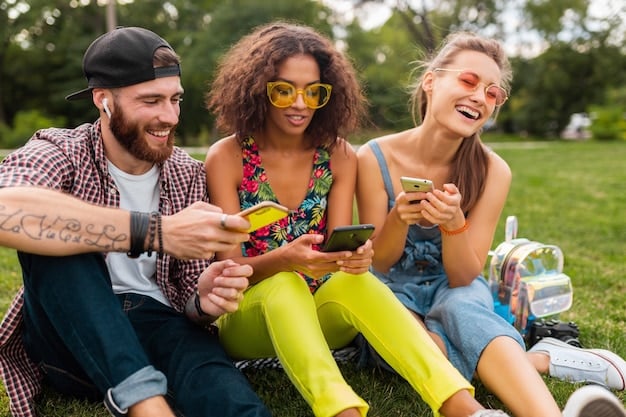Mental Health in the Digital Age: Managing Anxiety & Depression

Mental Health in the Digital Age focuses on the strategies and practices to navigate anxiety and depression in an increasingly tech-driven world, emphasizing digital mindfulness, balanced tech usage, and leveraging online resources responsibly.
The digital age has revolutionized how we live, work, and connect, but it also presents unique challenges to our mental well-being. Understanding the impact of technology on our minds is the first step in reclaiming a sense of balance. This article aims to shed light on Mental Health in the Digital Age: Strategies for Managing Anxiety and Depression in a Tech-Driven World, offering practical strategies to navigate the digital landscape while safeguarding our mental health.
Understanding the Digital Impact on Mental Health
The pervasive nature of technology has undeniably shaped our mental health in profound ways. While offering connectivity and access to information, digital tools can also contribute to anxiety, depression, and a general sense of overwhelm. Understanding these impacts is crucial for developing effective coping mechanisms.
The Double-Edged Sword of Social Media
Social media platforms, intended to connect us, can often foster feelings of inadequacy and social comparison. The curated portrayals of others’ lives can lead to anxiety and depressive symptoms.
- Constant comparison with others’ highlight reels.
- Fear of missing out (FOMO) and its impact on self-esteem.
- Cyberbullying and online harassment.
The Always-On Culture
The expectation of constant availability, driven by smartphones and internet connectivity, can create a state of chronic stress, blurring the lines between work and personal life.

The impact of digital devices on mental health is multi-faceted. From sleep deprivation and eye strain to social isolation and exposure to online content, these challenges can lead to various mental health issues.
Strategies for Digital Mindfulness
Digital mindfulness is the practice of being present and intentional with our technology use. It’s about making conscious choices about how and when we engage with digital devices, rather than being passively swept along by them.
Implementing strategies for digital mindfulness allows us to take control of our habits and avoid negative effects on our mental health.
Setting Boundaries with Tech
Establishing clear boundaries with technology is essential for maintaining a healthy work-life balance and reducing digital stress. It means being proactive in setting limits and creating dedicated time for offline activities.
- Designating tech-free zones in the home, such as bedrooms and dining areas.
- Establishing specific times throughout the day for checking emails and social media.
- Using app timers and website blockers to limit usage on distracting platforms.
Practicing Mindful Consumption
Being mindful of the content we consume online can drastically reduce exposure to negativity and promote mental well-being. It involves consciously selecting feeds, muting or unfollowing accounts that trigger anxiety, and being aware of the emotional impact of online interactions.
Cultivating Real-Life Connections
In an increasingly digital world, nurturing genuine human connections is more important than ever. Building strong, supportive relationships can act as a buffer against the negative effects of technology on our mental health.

Social interactions can significantly impact our mental well-being. Fostering and nurturing these connections leads to an improvement in overall mental health.
Prioritizing Face-to-Face Interactions
Face-to-face interactions offer a depth of connection that cannot be replicated online. Making an effort to spend quality time with loved ones can greatly enhance emotional well-being.
Real-life connections reduce the risk of mental health issues related to social isolation and provide a supportive social network, improving emotional resilience.
From regular community activities and organized sports, to group classes and volunteering, there are many opportunities to make new friends and enjoy life offline.
Leveraging Technology for Mental Wellness
While technology can contribute to mental health challenges, it can also be a powerful tool for promoting well-being. There are numerous apps and resources available that offer support, guidance, and strategies for managing anxiety and depression.
Exploring Mental Health Apps
Mental health apps can provide convenient access to therapy, meditation, mood tracking, and other valuable resources. Finding the right app can be a game-changer for managing your mental well-being.
- Researching apps developed by reputable organizations.
- Reading user reviews to understand the experiences of others.
- Trying out free trials or demo versions to test the app before committing to a subscription.
These apps promote mental well-being through guided meditations, mood tracking, therapy support, and educational resources, improving access and availability of mental health care.
Online Therapy and Support Groups
Teletherapy platforms offer a convenient and accessible way to connect with licensed therapists from the comfort of your own home. Online support groups can also provide a sense of community and shared experience.
Online counseling and support groups offer convenient, private, and accessible mental health services, enabling more people to get care when they need it.
Creating a Balanced Digital Diet
Just as we strive for a balanced diet to nourish our bodies, we can aim to create a balanced digital diet to nourish our minds. This means being intentional about the content we consume and the amount of time we spend online.
Implementing a balanced digital diet greatly promotes mental health stability and reduces anxiety and depression symptoms.
Curating Your Online Feeds
Taking control of your online feeds by unfollowing accounts that trigger negativity and seeking out positive, uplifting content can transform your digital experience.
Curating your online feeds enhances mental health, while exposure to diverse, positive content promotes feelings of connection and support.
It’s crucial to be selective using online platforms, tailoring your digital experience to support mental well-being and create habits that foster positivity.
Seeking Professional Help
While self-help strategies can be effective for managing mild anxiety and depression, it’s important to recognize when professional help is needed. If your symptoms are persistent or interfering with your daily life, reaching out to a mental health professional is a sign of strength, not weakness.
Recognizing When to Seek Help
Persistent feelings of sadness, hopelessness, or worthlessness are red flags that warrant professional evaluation and intervention.
- Changes in sleep patterns (insomnia or excessive sleeping).
- Loss of interest in activities you once enjoyed.
- Difficulty concentrating or making decisions.
Mental health professionals have the expertise to diagnose and treat mental health conditions effectively, offering a path toward recovery and improved quality of life.
| Key Point | Brief Description |
|---|---|
| 📱 Digital Mindfulness | Practice intentional tech use. Set boundaries to reduce digital stress. |
| 🤝 Real-Life Connections | Prioritize face-to-face interactions to enhance emotional well-being. |
| 💡 Tech for Wellness | Use mental health apps and online therapy for support and guidance. |
| ⚖️ Balanced Digital Diet | Curate online feeds and limit screen time to nourish your mind. |
[Frequently Asked Questions]
▼
Social media can lead to feelings of inadequacy and comparison, contributing to anxiety and depression. Curated portrayals of others’ lives often create unrealistic expectations and a sense of FOMO.
▼
Digital mindfulness is being intentional and present with your technology use. It involves setting boundaries, practicing mindful consumption, and consciously deciding when and how to engage with digital devices.
▼
Yes, technology can be leveraged for mental wellness. Mental health apps offer meditation, mood tracking, and access to therapy. Online therapy and support groups can also provide community and professional assistance.
▼
To create a balanced digital diet, curate your online feeds by unfollowing negative accounts and seeking positive content. Limit screen time and prioritize real-life connections to nourish your mental well-being.
▼
Seek professional help if you experience persistent feelings of sadness, hopelessness, or worthlessness. Changes in sleep patterns, loss of interest in activities, and difficulty concentrating are also red flags.
Conclusion
Navigating the digital age requires a conscious and proactive approach to mental health. By implementing strategies for digital mindfulness, prioritizing real-life connections, and leveraging technology for wellness, we can strike a balance that supports our mental and emotional well-being. Remember, it’s crucial to recognize when professional help is needed and to prioritize your mental health above all else.





